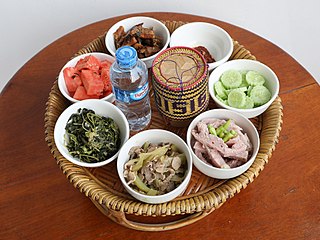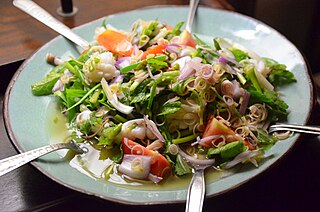| This article is part of the series on |
| Indian cuisine |
|---|
 |
Mizo cuisine is the traditional cuisine of the Mizo people of Mizoram, India. Mizos are traditionally rice eaters.
| This article is part of the series on |
| Indian cuisine |
|---|
 |
Mizo cuisine is the traditional cuisine of the Mizo people of Mizoram, India. Mizos are traditionally rice eaters.
The cuisine of Mizoram shares characteristics to other regions of Northeast India and North India. Rice is the staple food of Mizoram, while Mizos love to add non-vegetarian ingredients in every dish. Fish, chicken, pork and beef are popular meats among Mizos. Dishes are cooked in any available oil. Meals tend to be blander with less oil and more vegetables. Most Mizos love eating boiled vegetables along with rice but the younger generation tends to like fried and spicy food; food from other cultures are also a popularity among many young Mizo. A popular dish is bai, made from boiling vegetables (the ingredients tend to differ from household to household) with bekang (fermented soybeans) or sa-um, a fermented pork, and served with rice. Sawhchiar is another common dish, made of rice and cooked with beef, pork or chicken. [1] [2]
The staple food of most of the Mizo people is rice, with meat and vegetables served on the side, ranging from the homely bai, a simple vegetable stew, non veg stew with sesame, garlic, onion and herbs. [3]


Lunch in a Mizo home differs from house to house .Food eaten in lunch can range from Simple biscuits to even noodles and also sometimes "chhangban" (a snack prepared from finely ground sticky rice) which is usually accompanied by kurtai (jaggery) and tea. Some of the Items eaten during lunch are :

Thai cuisine is the national cuisine of Thailand.

Vietnamese cuisine encompasses the foods and beverages of Vietnam. Meals feature a combination of five fundamental tastes : sweet, salty, bitter, sour, and spicy. The distinctive nature of each dish reflects one or more elements, which are also based around a five-pronged philosophy. Vietnamese recipes use ingredients like lemongrass, ginger, mint, Vietnamese mint, long coriander, Saigon cinnamon, bird's eye chili, lime, and Thai basil leaves. Traditional Vietnamese cooking has often been characterised as using fresh ingredients, not using much dairy or oil, having interesting textures, and making use of herbs and vegetables. The cuisine is also low in sugar and is almost always naturally gluten-free, as many of the dishes are rice-based instead of wheat-based, made with rice noodles, papers and flour. Vietnamese cuisine is strongly influenced not only by the cuisines of neighboring China, Cambodia and Laos, but also by French cuisine due to French colonial rule over the region from 1887 to 1954.

Lao cuisine or Laotian cuisine is the national cuisine of Laos.
Malaysian cuisine consists of cooking traditions and practices found in Malaysia, and reflects the multi-ethnic makeup of its population. The vast majority of Malaysia's population can roughly be divided among three major ethnic groups: Malays, Chinese and Indians. The remainder consists of the indigenous peoples of Sabah and Sarawak in East Malaysia, the Orang Asli of Peninsular Malaysia, the Peranakan and Eurasian creole communities, as well as a significant number of foreign workers and expatriates.

Malay cuisine is the traditional food of the ethnic Malays of Southeast Asia, residing in modern-day Malaysia, Indonesia, Singapore, Brunei, Southern Thailand and the Philippines as well as Cocos Islands, Christmas Island, Sri Lanka and South Africa.

Fried rice is a dish of cooked rice that has been stir-fried in a wok or a frying pan and is usually mixed with other ingredients such as eggs, vegetables, seafood, or meat. It is often eaten by itself or as an accompaniment to another dish. Fried rice is a popular component of East Asian, Southeast Asian and certain South Asian cuisines, as well as a staple national dish of Indonesia. As a homemade dish, fried rice is typically made with ingredients left over from other dishes, leading to countless variations. Fried rice first developed during the Sui Dynasty in China.

Cambodian cuisine is an umbrella term for the cuisines of all ethnic groups in Cambodia, whereas Khmer cuisine refers specifically to the more than thousand years old culinary tradition of the Khmer people. Over centuries, Cambodian cuisine has incorporated elements of Indian, Chinese and more recently French cuisine, and due to some of these shared influences and mutual interaction, it has many similarities with the neighbouring Thai, Vietnamese and Lao cuisines.

Singaporean cuisine is derived from several ethnic groups in Singapore and has developed through centuries of political, economic, and social changes in the cosmopolitan city-state.

Filipino cuisine is composed of the cuisines of more than a hundred distinct ethnolinguistic groups found throughout the Philippine archipelago. A majority of mainstream Filipino dishes that compose Filipino cuisine are from the food traditions of various ethnolinguistic groups and tribes of the archipelago, including the Ilocano, Pangasinan, Kapampangan, Tagalog, Bicolano, Visayan, Chavacano and Maranao ethnolinguistic groups. The dishes associated with these groups evolved over the centuries from a largely indigenous base shared with maritime Southeast Asia with varied influences from Chinese, Spanish and American cuisines, in line with the major waves of influence that had enriched the cultures of the archipelago and adapted using indigenous ingredients to meet local preferences.

Parkia speciosa, the bitter bean, twisted cluster bean, sator bean, or stink bean, is a plant of the genus Parkia in the family Fabaceae. It bears long, flat edible beans with bright green seeds the size and shape of plump almonds which have a rather peculiar smell, similar to, but stronger than that of the shiitake mushroom, due to sulfur-containing compounds also found in shiitake, truffles and cabbage.

Noodle soup refers to a variety of soups with noodles and other ingredients served in a light broth. Noodle soup is a common dish across East Asia, Southeast Asia and the Himalayan states of South Asia. Various types of noodles are used, such as rice noodles, wheat noodles and egg noodles.

Peranakan cuisine or Nyonya cuisine comes from the Peranakans, descendants of early Chinese migrants who settled in Penang, Malacca, Singapore and Indonesia, inter-marrying with local Malays. In Baba Malay, a female Peranakan is known as a nonya, and a male Peranakan is known as a baba. The cuisine combines Chinese, Malay, Javanese, South Indian, and other influences.

The cuisine of the Democratic Republic of the Congo and the Republic of the Congo varies widely, representing the food of indigenous people. Cassava, fufu, rice, plantain and potatoes are generally the staple foods eaten with other side dishes.
Naga cuisine is the traditional foods of the Naga people in the Northeastern region of India and Northwestern region of Myanmar. Each ethnic group of the Nagas prepares its own unique style of cuisines. It most notably features rice, meats and leaf vegetables. Meat prepared by the Nagas are often smoked, dried or fermented.

Javanese cuisine is the cuisine of Javanese people, a major ethnic group in Indonesia, more precisely the province of Central Java, Yogyakarta and East Java.

A meatball is ground meat rolled into a ball, sometimes along with other ingredients, such as bread crumbs, minced onion, eggs, butter, and seasoning. Meatballs are cooked by frying, baking, steaming, or braising in sauce. There are many types of meatballs using different types of meats and spices. The term is sometimes extended to meatless versions based on vegetables or fish; the latter are also commonly known as fish balls.

Khanom chin are fresh, thin rice noodles in Thai cuisine which are made from rice sometimes fermented for three days, boiled, and then made into noodles by extruding the resulting dough through a sieve into boiling water. Khanom chin is served in many kinds of stock: coconut milk, fish curry, and chilli. Although chin means "Chinese" in Thai, this type of noodle originated from the Mon people who inhabited the region which is now central Thailand The word khanom chin is probably derived from the Mon words hanom cin, or "boiled noodles."

Salads that are internationally known as Thai salads with a few exceptions fall into four main preparation methods. In Thai cuisine these are called yam, tam, lap and phla. A few other dishes can also be regarded as being a salad.

Indonesian noodles are a significant aspect of Indonesian cuisine which is itself very diverse. Indonesian cuisine recognizes many types of noodles, with each region of the country often developing its own distinct recipes.